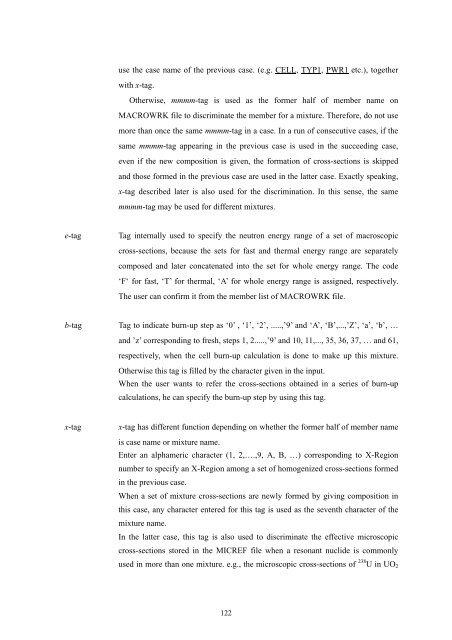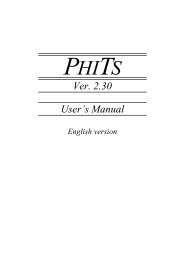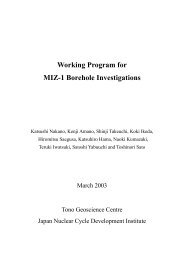JAEA-Data/Code 2007-004 - Welcome to Research Group for ...
JAEA-Data/Code 2007-004 - Welcome to Research Group for ...
JAEA-Data/Code 2007-004 - Welcome to Research Group for ...
You also want an ePaper? Increase the reach of your titles
YUMPU automatically turns print PDFs into web optimized ePapers that Google loves.
use the case name of the previous case. (e.g. CELL, TYP1, PWR1 etc.), <strong>to</strong>gether<br />
with x-tag.<br />
Otherwise, mmmm-tag is used as the <strong>for</strong>mer half of member name on<br />
MACROWRK file <strong>to</strong> discriminate the member <strong>for</strong> a mixture. There<strong>for</strong>e, do not use<br />
more than once the same mmmm-tag in a case. In a run of consecutive cases, if the<br />
same mmmm-tag appearing in the previous case is used in the succeeding case,<br />
even if the new composition is given, the <strong>for</strong>mation of cross-sections is skipped<br />
and those <strong>for</strong>med in the previous case are used in the latter case. Exactly speaking,<br />
x-tag described later is also used <strong>for</strong> the discrimination. In this sense, the same<br />
mmmm-tag may be used <strong>for</strong> different mixtures.<br />
e-tag<br />
Tag internally used <strong>to</strong> specify the neutron energy range of a set of macroscopic<br />
cross-sections, because the sets <strong>for</strong> fast and thermal energy range are separately<br />
composed and later concatenated in<strong>to</strong> the set <strong>for</strong> whole energy range. The code<br />
‘F‘ <strong>for</strong> fast, ‘T’ <strong>for</strong> thermal, ‘A’ <strong>for</strong> whole energy range is assigned, respectively.<br />
The user can confirm it from the member list of MACROWRK file.<br />
b-tag<br />
Tag <strong>to</strong> indicate burn-up step as ‘0’ , ‘1’, ‘2’, .....,’9’ and ‘A’, ‘B’,...,’Z’, ‘a’, ‘b’, …<br />
and ’z’ corresponding <strong>to</strong> fresh, steps 1, 2.....,’9’ and 10, 11,..., 35, 36, 37, … and 61,<br />
respectively, when the cell burn-up calculation is done <strong>to</strong> make up this mixture.<br />
Otherwise this tag is filled by the character given in the input.<br />
When the user wants <strong>to</strong> refer the cross-sections obtained in a series of burn-up<br />
calculations, he can specify the burn-up step by using this tag.<br />
x-tag<br />
x-tag has different function depending on whether the <strong>for</strong>mer half of member name<br />
is case name or mixture name.<br />
Enter an alphameric character (1, 2,….,9, A, B, …) corresponding <strong>to</strong> X-Region<br />
number <strong>to</strong> specify an X-Region among a set of homogenized cross-sections <strong>for</strong>med<br />
in the previous case.<br />
When a set of mixture cross-sections are newly <strong>for</strong>med by giving composition in<br />
this case, any character entered <strong>for</strong> this tag is used as the seventh character of the<br />
mixture name.<br />
In the latter case, this tag is also used <strong>to</strong> discriminate the effective microscopic<br />
cross-sections s<strong>to</strong>red in the MICREF file when a resonant nuclide is commonly<br />
used in more than one mixture. e.g., the microscopic cross-sections of 238 U in UO 2<br />
122







